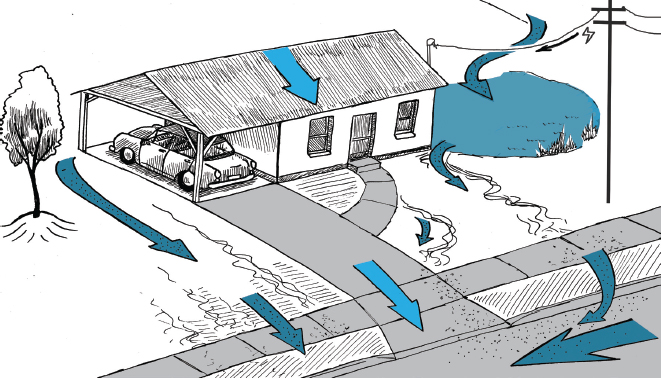
Catch rain where rain falls.
—East Indian proverb
I love the rain! I love to drink it, sing in it, dance in it, bathe in it. Of course that’s only natural; our bodies are more than 70% water. You and I and everyone else—we’re walkin’, talkin’, rain.
Rain is the embodiment of life. It infuses water into our springs, rivers, and aquifers. It cools us, greens the land, and nourishes the plants that feed us. It cleans the air, washes salts from the soil, and makes the animals sing.
Yet the world’s supply of fresh water is finite. Less than one half of one percent of all the water on Earth is fresh and available. The rest is seawater, or frozen. Our supply is renewed only through precipitation, a precious gift from the sky that falls as droplets, hail, or snowflakes, and then flows over the landscape as runoff. In this book, I refer to the gift as “rainwater.” And the gift is ripe for harvesting.
Rainwater harvesting captures precipitation and uses it as close as possible to where it falls. The process mimics intact and healthy ecosystems, which naturally infiltrate rainwater into the soil and cycle it through myriad life forms. Instead of sealing and dehydrating the landscape with impervious pavement and convex shapes that drain the gift away, as most modern cities, suburbs, and home landscapes do, harvesting accepts rain and allows it to follow its natural path to productivity.
This book provides you with a simple series of integrated strategies for creating water-harvesting “nets” which allow rainwater to permeate and enhance our landscapes, gardens, yards, parks, farms, and ranches. Small-scale strategies are the most effective and the least expensive, so they are emphasized here. They’re also the safest and easiest to accomplish. They can empower you to become more water self-sufficient, and resilient in times of changing climates or a break in the water or power line.
The benefits are many. By harvesting rainwater within the soil and vegetation—in the land, or in cisterns that will later irrigate the land, we can decrease erosion, reduce flooding, minimize water pollution, and prevent mosquito breeding (within water standing on top of the soil for more than three days). The process also generates an impressive array of resources: It can provide drinking water, generate high quality irrigation water, support vegetation as living air conditioners and filters, lower utility bills, enhance soil fertility, grow food and beauty, increase local water resources, reduce demand for groundwater, boost wildlife habitat, and endow us and our community with skills of self-reliance and cooperation!
MY RAINWATER-HARVESTING EVOLUTION
In 1994, my brother Rodd and I began harvesting water in our backyard by digging, then mulching a basin around a single drought-stressed sour orange tree. We graded the soil around the basin so runoff from the surrounding area, and the neighbor’s roof would drain to the tree. The results amazed us. After a single rain, the tree burst out with new leaves, a dreamy show of fragrant blossoms, and an abundant crop of fruit that was soon converted into tasty marmalade and “orangeade” by family, friends, and neighbors. Ten years later, we’ve since kept our irrigation of that tree to just three supplemental waterings per year. Yet we live within the Sonoran Desert where annual rainfall averages just over 11 inches (282 mm), and most folks water their citrus trees at least once a week.
With the citrus tree flourishing, we decided to mimic its success and make rainwater the primary water source for all our outdoor needs. Using methods described in chapters 3, 4, and 5, and more in depth in volume 2, we created and planted undulating water-harvesting earthworks throughout our once barren yard. The rain then gently soaked into the soil, soil erosion ceased, and verdant life began sprouting everywhere. We planted shade trees that grew tall around the house, lowering summer temperatures enough for us to eliminate our evaporative cooler (improved insulation, painting the house’s exterior white, and passive ventilation also helped). We then boosted the growth of these trees still further using greywater recycled from the drains of our home’s sinks, shower, and washing machine. Our daily municipal water use dropped from the Tucson residential average of 112 gallons (424 liters) per person per day1 to less than 20 gallons (75 liters) per person per day, and our water and electric bills plummeted. This earned us five visits from workers at both the water and electric utilities because they were sure our meters were broken.
We wanted to do more. Every time it rained our street turned into a river, fed by runoff from neighborhood roofs, yards, and pavement. We redirected that runoff to 19 young native trees we planted in the barren public right-of-way adjacent to our property. These low-water-use trees now sing with nesting songbirds and offer a beautiful shaded canopy for pedestrians, bicyclists, and motorists. Water that once flowed away now supports trees that filter pollutants carried in the road’s runoff as they shade and cool the street (see the chapter on reducing hardscape and creating permeable paving in volume 2 for more details). Mosquito populations have plunged because water no longer stands in puddles, but is instead soaked up by spongy mulch and taken up by plants.
Our lot was once hot, barren and eroded, with a house that could only be made comfortable by paying to mechanically alter its climate. Now our yard is an oasis producing 15 to 25% of our food, and after growing trees and installing solar panels to power fans, we no longer pay a cent to heat and cool our home (keep in mind we are also the type that will put on a sweater before firing up a wood stove). We’ve switched from contributing to neighborhood flooding to contributing to neighborhood flood control, and our landscape enhances local water resources instead of depleting them. On our 1/8-acre (0.05-ha) lot and surrounding right-of-way we currently harvest annually over 95,000 gallons (359,600 liters) of rainwater within two 1,300-gallon (4,920-liter) and two 1,000-gallon (3,780-liter) tanks, the soil, and vegetation. Meanwhile, we use less than 20,000 gallons (75,700 liters) of municipal water for our domestic needs, neighbors using the community washing machine on our site, and landscape irrigation in dry spells. Four-fifths of the water we now use comes from our own yard, not from city supply.
When friends and neighbors drop by they see the potential of water harvesting and learn how to do it themselves. Many then go home and spread the “seeds” by setting up work parties and creating their own rain-fed oases. That, in essence, is my vision: Harvest rainwater within our own yards and neighborhoods, encourage emulation, enhance rather than deplete our water resources, and improve the lives of everyone in our community.
This has become my passion and my profession. Fueled by what I’ve learned from hands-on experience, I’ve taught countless workshops on rainwater harvesting and permaculture—an integrated system of sustainable design. I’ve designed and consulted on self-sustainable water-harvesting strategies and systems for many backyard gardeners, neighborhoods, city projects, land restoration endeavors, and major housing developments. And all these projects and teachings are based on the principles I give you in this book. It is my hope to plant more water-harvesting “seeds.”
If every neighborhood in my hometown, and yours, harvested rainwater in an integrated way we could greatly reduce the need for our concrete-clad, water-draining, multi-million dollar flood control infrastructure. Our yards and public right-of-ways would become a new tree-lined, water-harvesting greenfrastructure, no longer requiring us to spend billions extracting and importing water from other communities to supplement our drained and dwindling supply.
The economics speak for themselves. By valuing and harvesting the ignored resource of rain, groundwater levels can stabilize and even rise again, failing springs and creeks can come back to life, native plants can recolonize wasteland, and ultimately the global hydrologic cycle can benefit, while we simultaneously reduce our cost of living! Real life examples of these scenarios permeate this book, encouraging us to think globally as we act locally.
How do we get there? We become aware, apply our awareness, and throw down the welcome mat to invite rainwater into our lives and landscape.
WHO THIS BOOK IS FOR
This book, along with volumes 2 and 3, is for anyone who wants to harvest rainwater in a safe, productive, sustainable way. You can be the expert and steward of your land, whether you live on an urban or rural site, big or small. This book explains what water harvesting is, how to do it, and how to apply it to the unique conditions of your site. The aim is to realize the maximum effectiveness for the least effort and cost. You’ll be guided in the design of new water-harvesting landscapes or in the retrofit of ones that exist.
This book will also help you convey water-harvesting ideas to the landscape designers and maintenance workers who may be helping you at your site. Planners and designers will discover how to devise more efficient strategies and integrated environments appropriate for dryland communities as well as those with abundant water. Landscapers and gardeners will learn how to create and maintain water-harvesting earthworks. Activists will learn how water-harvesting projects can bring people together, create a sense of place, and empower the community.
Box I.1. Drylands: A Definition
Drylands are typically defined as areas of the world where potential average yearly moisture loss (evapotranspiration) exceeds average yearly moisture gain (precipitation). Evapotranspiration is the combined measurement of water loss to evaporation and transpiration.2 Transpiration is the loss of moisture from plants to the air via the stomata within their leaves.
More than 6.1 billion hectares, 47.2% of the Earth’s land surface, is dryland. A fifth of the world’s population lives in dryland habitat.3 Normal dry seasons can last six months or more. Droughts can last for years.
Dryland-appropriate strategies are emphasized throughout this book, because this is where the need is the greatest (see box I.1). Many are borrowed from, or based on, traditions that have allowed people to survive and thrive in arid environments for thousands of years (appendix 2). Yet the principles are universally applicable; wet and dry climates are both susceptible to drought and flooding. Rainwater harvesting reduces the impacts of dry seasons, droughts, and floods. By optimizing the capture of the rain we buffer our lands from changing climates and climatic extremes, while making our lands more resilient.
My goal is to enable you to appreciate the value of rainwater and other on-site resources, and begin to use rainwater as your primary water source—if not for the entire household, at least for your landscape. You’ll not only get the most from rainfall, no matter how scarce, but from other water sources as well. An integrated landscape harvests all water and builds up such resources as topsoil, organic matter, and nutrients. It acts as a concave, life-giving sponge rather than a convex, eroding burial mound, which drains water and other resources away. (See figure I.1.)
Fig. I.1A. A home and landscape draining and consuming resources.
Blue arrows denote runoff flow (dots within dirty blue arrows denote sediment). Black arrow denotes electricity flow.

Fig. I.1B. A home and landscape harvesting and producing resources.
Blue arrows denote cleaner runoff flow. Dirty blue arrows denote dirtier runoff flow. Black arrow denotes electricity flow. Dashed lines denote greywater pipe. Solar panels and solar hot water heater added to roof
HOW TO USE THIS BOOK AND VOLUMES 2 AND 3
From the start, I’ve intended Rainwater Harvesting for Drylands and Beyond to be an all-in-one source on how to conceptualize, design, and implement integrated and sustainable rainwater-harvesting systems. And it has grown and grown with ongoing research, experience, insights, and exposure to the great work of others. The result was the resource I’ve always wanted! But it took the form of a massive single volume too intimidating in size to the uninitiated and too large to easily carry while observing a site, brainstorming design ideas, or implementing the plan. So, I’ve divided the book up into three user-friendly, more portable volumes. I strongly recommend everyone read volume 1, since it puts all three volumes in context and lays down the foundation of how to conceptualize a truly efficient and productive integrated system that can do far more than just harvest rainwater. Volumes 2 and 3 then expand on this by elaborating on how to employ the specific techniques that flesh out and realize the general strategies presented in volume 1. Volume 2 focuses on earthworks passively harvesting rainwater and greywater within the landscape. Volume 3 focuses on roof catchment and cistern systems. In addition, my website, HarvestingRainwater.com offers continually expanded resources, research, and stories of those successfully harvesting and enhancing local on-site assets such as water, sun, shade, soil, food, and community.
Here’s a more detailed breakdown:
VOLUME 1
The Introduction makes the case for harvesting rainwater and shifting to a paradigm of more sustainable water management.
The following chapters in this volume then lay out the steps for creating an integrated water-harvesting system:
Chapter 1 is intended to help you conceptualize the basic water-harvesting principles that will enable you to create a system that maximizes safety, efficiency, and productivity. This chapter is the core of the book and the heart of successful water harvesting.
In chapter 2, you will walk your watershed and assess your site’s water resources.
Chapters 3 and 4 are intended to be an overview of the kinds of techniques you can use.
Chapter 3 is a discussion which will determine which of the water-harvesting strategies (earthworks, cisterns, or both) would be best for your site and needs. It also provides an overview of and illustrations of various earthworks techniques, and some illustrations and discussion of tanks.
Chapter 4 discusses integrating other on-site resources into your system such as sun, wind, and shade to get more than rainwater for your harvesting efforts.
Chapter 5 describes how my family and neighborhood have implemented many of the strategies presented throughout this book.
There are several appendices. Appendix 1 shows patterns of water and sediment flow with their potential water-harvesting response. Appendix 2, by Joel Glanzberg, is about traditional Native American water-harvesting techniques in the Southwest. Appendix 3 gives you many water-harvesting calculations. Appendix 4 provides a list of example plants and their water requirements, and while this list is specifically for Tucson, Arizona, other readers may find it useful. Appendix 5 provides sample worksheets for figuring onsite water resources, water budgets, etc., and is intended as a structure to write down your observations and calculations for future reference. Appendix 6 in this book is a distilled list of rainwater harvesting resources. A longer version of appendix 6, divided into sections, is at HarvestingRainwater.com. Appendix 7 provides information about sun angles and paths. This information is to key to integrated design, and enables you to passively heat, cool, and power your home for free. Appendix 8 illustrates how to harvest and deflect the wind along with optimal window placement maximizing passive ventilation. Appendix 9 shows you how everything is connected with the water-energy-carbon nexus, and how integrated water harvesting also saves energy and money, while dramatically reducing emissions of carbon and other pollutants.
There are also reference notes, a glossary, and an index.
VOLUME 2: EARTHWORKS
In this volume, you will learn how to select, place, and construct your chosen water-harvesting earthworks. It presents detailed how-to information and variations of all the earthworks, including chapters on mulch, vegetation, and greywater recycling so you can customize the techniques to the unique requirements of your site.
VOLUME 3: ROOF CATCHMENT AND CISTERN SYSTEMS
Here, you will learn to select, size, design, build or buy, and install your chosen roof catchment and cistern systems. Principles unique to cistern systems are presented along with numerous tank options, and design strategies that enable your tank to do more than harvest water.
Real life stories of people creating and living with water-harvesting landscapes and systems frame all three volumes. We have honed our skills through countless hours of hands-on design, implementation, maintenance, and living with our systems. The scale and context of some of the systems presented may seem too large, too small, too urban, or too rural to apply to your site, but keep in mind that if you grasp how the principles and ethics have been realized in the various systems, you can adapt them to the scale and context your site requires.
THE VALUE OF RAINWATER
Don’t pray for rain, if you can’t take care of what you get.
—R. E. Dixon (1937) Superintendent, Texas Agricultural Experiment Station, Spur, Texas
So, you want to harvest rainwater—right on! Let’s celebrate the value of rainwater and the many water resources it supports, because how we value our water resources directly relates to how we perceive, utilize, and manage them.
Precipitation (rain, hail, sleet, and snowfall) is the primary source of fresh water within our planet’s hydrologic cycle. This precipitation, or “rain,” supplies all secondary sources of water, including groundwater and surface water in creeks, rivers, and lakes. If consistently pumped or drained faster than they are replenished, these secondary sources eventually cease to exist.
Precipitation is naturally distilled through evaporation prior to cloud formation (Fig. I.2), and thus is one of our purest sources of water.4 Rainwater has about 100 times less total dissolved solids (TDS) than ground and surface water in my hometown!5
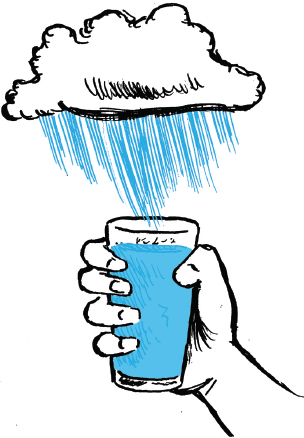
Fig. I.2. Pure rainwater
Rain is considered soft due to the lack of calcium carbonate or magnesium in solution, and is excellent for cooking, washing, and saving energy. Much of our ground and surface water is hard due to the calcium and magnesium compounds that dissolve as water runs through or over soil. These compounds deposit on or in cookware, pipes, and water heaters forming white “scale” that inhibits heat conduction and shortens pipe and appliance life. Using rainwater instead saves energy and maintenance costs, and can prolong the life of water heaters and pipes.6 Rainwater use also reduces detergent and soap requirements, and eliminates soap scum, hardness deposits, and the need for a water softener (sometimes required with well water systems),7 besides being a natural hair conditioner.
Rainwater is a natural fertilizer. According to cooperative extension agent John Begeman, rain contains sulfur—important in the formation of plant amino acids, and it contains beneficial microorganisms and mineral nutrients collected from dust in the air— important for plant growth. Rainwater also contains nitrogen, which triggers the greening of plants. During storms, lightning strikes enable atmospheric nitrogen to combine with hydrogen or oxygen to form ammonium and nitrate, two forms of nitrogen that go into solution in atmospheric moisture and can be used by plants.8
Rainwater has the lowest salt content of natural fresh water sources so it is a superior water source for plants. Calcium, magnesium, potassium, and sodium salts are abundant in the earth’s crust. Soils with high salt concentrations inhibit plant growth by reducing vegetation’s ability to take up water and conduct photosynthesis.9 Soils high in sodium have a tendency to disperse—or lose their structure—resulting in poor water infiltration, and soil crusting, which restricts root penetration and impedes seedling emergence.10 As David Cleveland and Daniela Soleri write in Food From Dryland Gardens, “Salty soils occur naturally in arid areas where not enough rain falls to wash soluble salts down and out of the root zone. Irrigation [with surface or groundwater] makes the situation worse, since surface water and groundwater contain more salt than rainwater. Salt tends to build up in the soil as water is continually added through irrigation.”11 As long as the soil drains and enough rainwater is applied, rainwater can dilute these salts and flush them out of the root zone.12
Rainwater comes to us free of charge. It falls from the sky and we don’t pay to pump it nor do we pay a utility company to deliver it (Fig. I.3).
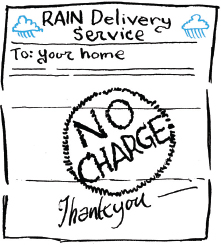
Fig. I.3. Rain is always free.
Yet, current management of household and community water resources does not reflect the true value of rain. Rather than treating it as our primary renewable source of fresh water we typically treat rainwater as a nuisance, diverting it to the storm drain, drainage ditch, or pollutant-laden street. In its place we invest vast resources acquiring lower-quality, secondary sources of ground and surface water. Such contemporary water management contrasts sharply with rainwater-harvesting traditions.
RAINWATER HARVESTING THROUGH LAND AND TIME
Around the globe, traditions and historic evidence of rainwater harvesting illustrate its importance as a primary water source. According to John Gould and Erik Nissen-Petersen, authors of Rainwater Catchment Systems for Domestic Supply, the origins of rainwater collection may extend as far back in human history as the use of fire as evidenced by the traditional practices of the hunter-gatherer Kalahari Bushmen (the San Peoples) collecting, storing, and burying rainwater in ostrich eggs to be recovered months or years later.
Roof runoff was the main source of water for many Phoenician and Carthaginian settlements from the sixth century B.C. into Roman times, when harvested rainwater became the primary water source for whole cities. As far back as 2,000 years, rain-fed cisterns provided domestic water throughout North Africa, the Mediterranean, the Middle East, and Thailand. There is a 4,000-year-old tradition of rainwater-collection systems for domestic supply and agriculture throughout the Indian subcontinent, and water harvesting in China may have extended back 6,000 years. Rooftop collection and storage of rainwater was the principal source of water in Venice, Italy from 300 to 1600 A.D. Aztec ground catchment systems were in use by 300 A.D. Native Americans in the Southwest desert used a variety of techniques (see appendix 2). Island cultures still rely on rainwater in parts of Japan, the Caribbean, and Polynesia. The tradition of harvesting rainwater in cisterns at isolated homesteads and farms continues today in the U.S., Canada, Australia, and New Zealand.13
We’ve moved away from these traditions over the past 150 years as new technologies have enabled us to access, pump, and transport huge volumes of groundwater and surface water: secondary water sources in the hydrologic cycle. These secondary supplies seemed infinite so we kept taking more. In 1930 there were 170 irrigation wells tapping the Ogallala aquifer that stretches 1,300 kilometers from the Texas panhandle to South Dakota; by 1959 there were over 42,000.14 As Charles Bowden writes, “By the sixties the High Plains had 5,500,000 acres under irrigation and men were working through the night to direct the flow from the ceaseless pumps.”15
Surface water and groundwater—secondary water sources in the hydrologic cycle—appeared to be more convenient, profitable, and dependable than rain— the primary source. Surface water and groundwater became the “primary” water resources in our modern water management system. Waste became more common than conservation. We came to see rain as a source of flooding that needed to be drained away. This appeared to work for a while, but the reality of this hydro-illiteracy has hit.
SCARCITY OR ABUNDANCE
While the hydrologic cycle continuously recycles earth’s water to produce renewed fresh rain, the rate at which fresh water is produced does not meet our ever-growing demand. In the face of this demand, our planet’s fresh water resources are finite. Current consumption rates are lowering groundwater levels and depleting surface water flows the world over. According to the Blue Gold Report, global water consumption is doubling every 20 years—more than twice the rate of human population growth. If current trends persist, by 2025 the demand for fresh water will be 56% more than is currently available.16 The Ogallala aquifer is being depleted eight times faster than nature can replenish it.17
We have reached a turning point in our water use and management. As my friend Brock Dolman says, “We can choose to be ‘scared in the city’ because of water scarcity, or we can choose water abundance— the fine and thriving condition in which ‘our buns can dance’!”
While I focus primarily on rainwater, the way we value ALL water resources shapes our future. In box I.2, I lay out the tenets of two contrasting paths of water use (see also figure I.4). Read on and ask yourself: What path am I on now? What path do I want to take from now on?
Fig. I.4A. A landscape on the wasteful path to scarcity.
Rain, runoff, and topsoil are quickly drained off the landscape to the street where the sediment-laden water contributes to downstream flooding and contamination. The landscape is dependent upon municipal/well water irrigation and imported fertilizer.
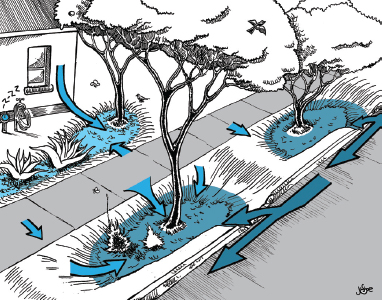
Fig. I.4B. A landscape on the stewardship path to abundance.
Rain, runoff, leaf drop, and topsoil are harvested and utilized within the landscape contributing to flood control and enhanced water quality. The system is self-irrigating with rain and self-fertilizing with harvested organic matter.
Box I.2. The Scarcity Path versus the Abundance Path
|
THE WASTEFUL PATH TO SCARCITY • Water scarcity is the condition in which our local water supply cannot continue to meet demand because our “fresh water bank account” is being drained. |
THE STEWARDSHIP PATH TO ABUNDANCE • Water abundance is the condition in which we adjust our patterns of water management and use until our locally available water supply meets and ultimately exceeds our needs. |
|
VALUES • We don’t value and appreciate water. • We treat rainwater as a problem—a substance we must get rid of. • We think of groundwater and surface water as infinitely available—substances we can afford to mismanage and waste. • We think that we as humans are separate and independent from nature. |
VALUES • We value all water, recognizing it as the basis of our living biological system. • We treat rainwater as the foundation of the life- sustaining hydrologic cycle. • We treat groundwater and surface water as reservoirs that naturally accumulate and concentrate rainwater, and do not waste these. • We understand and celebrate that we as humans are part of the earth’s natural system, which sustains us all. |
|
CHARACTERISTICS • As individuals and communities, we do not take responsibility for managing our own water accounts. • We continually draw on groundwater savings. • We don’t make new water deposits. |
CHARACTERISTICS • We as individuals and as communities thoughtfully manage our own water accounts. • We withdraw our groundwater savings only in times of true need. • We continually make water deposits. |
|
RESULTS • This extractive relationship with our natural resources leads to their degradation and depletion. |
RESULTS • The abundance path contributes to the regeneration of water and other renewable natural resources. We work to enhance the environment by providing the natural “compound interest” of healthy soil, plant, and animal communities that are the source of water, food, shelter, air, and beauty. |
DRAINING VERSUS INFILTRATING WATER
Living the wasteful path to scarcity
We drain our communities by diverting our rainwater away from rather than infiltrating it into our landscapes, waterways, and aquifers. We replace living nets of pervious vegetation and topsoil with impervious asphalt, concrete, and buildings, inducing rainwater to rush across the land and drain out of the system.
We create landscapes of burial-like mounds (convex shapes), which drain rather than retain water, topsoil, and organic matter. We place plants on top of these mounds, and pump water to them through an irrigation system, while rainwater drains away from the vegetation. Care packages of purchased fertilizer are applied to replace the lost topsoil and fertility. It is a system reminiscent of a hospitalized patient on an intravenous drip.
We direct roof runoff to streets and storm drains via gutters, downspouts, and landscaped river cobble “stream beds” that eject water quickly from yards. (See figure I.5A.)
Fig. I.5A. A landscape on life support draining its resources away. Note the mounded planted areas. Rainwater available to the landscape is reduced by up to 50% due to excessive runoff loss. Compare to figure I.5B.
• A report prepared by American Rivers states that the rapid expansion of paved-over and developed land in communities all across the U.S. is making the effects of drought worse. Development in Atlanta, Georgia and surrounding counties contributes to a yearly loss of rainwater infiltration ranging from 57 to 133 billion gallons. If managed on site, this rainwater—which could support annual household needs of 1.5 to 3.6 million people— would filter through the soil to recharge aquifers, and increase underground flows to replenish rivers, streams, and lakes.18,19
• Twenty-five percent of the land within incorporated Tucson is covered with impervious cover such as asphalt, concrete, or buildings.20 In higher density cities such as Los Angeles, California, over 60% of the land surface is covered with pavement.21
Living the stewardship path to abundance
We infiltrate rainwater into our soils and vegetation as close as possible to where it falls. We replace impervious surfaces with water-harvesting earthworks and tanks, and with spongy water-retaining mulch and vegetation to intercept and use runoff from sealed surfaces.
We construct bowl-like landscapes (concave shapes) to passively harvest rainwater, build topsoil, accumulate mulch, and reduce or eliminate the need for irrigation and fertilizer. This deposits the primary water source—rain—within our local soils, and reduces the need to use secondary surface water and groundwater resources.
We harvest stormwater runoff from streets into our landscapes. Streets then become passive irrigators of beautiful shade trees lining the streets and walkways. This inexpensive greenfrastructure reduces the need for conventional, costly, concrete-clad storm drains. (See figure I.5B.)
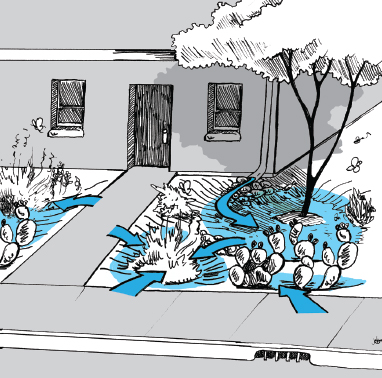
Fig. I.5B. A sustainable landscape infiltrating and harvesting on-site resources. Note the sunken, mulched planted areas and native vegetation. Rainwater available to the landscape is potentially tripled due to all rain falling on landscape infiltrating, in addition to runoff from roof, plus runoff from ground-level hardscapes. Compare to figure I.5A.
Box I.4. Infiltration Tips and Stories
• Convert driveways to gardenways. See volume 2, the chapter on reducing hardscape and permeable paving.
• Reduce impervious pavement or make it porous. See the above-mentioned chapter in volume 2.
• Hydrate rather than dehydrate communities. Across India traditional rainwater strategies are being revived to enhance local water resources. In the Alwar District people from 650 villages built or rejuvenated around 3,000 small earthen check dams conserving rainwater and increasing infiltration by 20%. Community-led forestry projects worked to reclaim cut and eroding lands. Sixteen years after the project’s beginning, groundwater levels have risen almost 20 feet (6 meters); forest cover increased by 33%; and five rivers that previously dried up each year now flow perennially. Increased agricultural production has exceeded the cost of the original investment by 4 to 1.22
See chapter 1 of this volume for a story of how infiltrated rainwater in Africa brought abundance to a man and his family.
OVER-EXTRACTION VERSUS CONSERVATION OF WATER
Living the Wasteful Path to Scarcity
We over-extract our local water sources by pumping wells and diverting water from rivers and springs faster than rainfall can naturally replenish them.
We reduce natural groundwater recharge—particularly in areas with shallow groundwater tables—by paving over surfaces and causing rapid rainfall runoff.23
As we drain more of our rainwater “deposits” away, we simultaneously pump and consume more of our ancient groundwater savings account. As a result, rivers dry up, water tables drop, pumping costs increase, riparian trees die, and water quality declines. (See figure I.6A.)
Fig. I.6A. Over-extracting groundwater
Box I.5. Over-Extraction Facts
In Arizona, groundwater pumping has dried up or degraded 90% of once-perennial streams, rivers, and riparian habitats.24
In California’s Central Valley, overuse of groundwater has collapsed the aquifer soil structure, causing a permanent loss of natural water storage capacity amounting to more than 40% of the combined storage capacity of all human-made dams and surface reservoirs in the state.25
In 1972, water diversion from China’s once mighty Yellow River prevented it from reaching the sea for the first time in history. That year the flow did not reach the ocean on 15 days. In 1997, it failed to reach the sea on 226 days.26
Living the stewardship path to abundance
We conserve our fresh water resources by utilizing rainwater, recycling all water, and by mulching, using low-flow appliances, installing greywater systems, and practicing integrated design to reduce fresh water needs.
We allow natural groundwater recharge to occur by maintaining soil- and vegetation-covered landscapes and healthy watersheds and waterways.
We make deposits to our water account by allowing water to recharge and accumulate in aquifers. We use ancient groundwater supplies only during times of drought and only to meet compelling needs.
Rainwater becomes our primary water source and our groundwater “savings accounts” are enriched and reserved for times of need.
We strive to live in sustainable balance with our local water resources by living within the constraints of our site’s rainwater resources/budget. (See figure I.6B.)
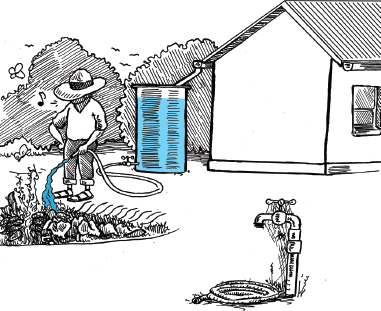
Fig. I.6B. Harvested rainwater conserving municipal/well water
Box I.6. Conservation Facts and Tips
The average American household could reduce water demands by 33 to 50% each year.27 Additional water-conserving technologies and methods could cut agricultural water demands by close to 50%, and industrial water demands by 50 to 90% without sacrificing economic output or quality of life.28
Conserving water saves energy, and conserving energy saves water. “Power plants that use coal, oil, natural gas, or uranium also need water for steam and cooling, and they take 131 billion gallons a day—more than five times as much water as people use in their homes.”29
Every kilowatt-hour (kWh) of coal-generated electricity uses about 1 pound of coal, produces 2 pounds of CO2, and uses just under 0.5 gallons of water.30,31 In addition, the burning of coal is our most dangerous means of generating electricity, contributing the bulk of the human-caused emissions of carbon dioxide into the atmosphere.32
Plant within your water budget. Create a landscape or garden that thrives within the constraints of your on-site rainwater and greywater resources. See chapter 2 for more.
Emphasize native plantings within your landscape. These plants have naturally adapted to survive on local rainfall patterns. They will thrive planted within water-harvesting earthworks or where given supplemental rainwater from a cistern! See volume 2, the chapter on vegetation.
Box I.7. Additional Water Conservation Strategies in the Home
See the Water Saver House website h2ouse.org for water conservation strategies around the home;
see appendix 9 for how these strategies also conserve energy and reduce pollution.
WASHING MACHINES
Replacing a standard washing machine that uses 30 to 50 gallons (114–189 liters) per load of wash with a new Energy Star™ certified washer that uses 10 gallons (38 liters) per load of wash can reduce water consumption by 30–60% and reduce energy consumption by 50% per load.33,34 For an average American household that’s a savings of nearly 7,000 gallons (26,500 liters) a year.35 Install a greywater system for your washer to recycle the wash water within your landscape.
PLUMBING LEAKS
Ten percent of a home’s water consumption can be due to leaks. Older irrigation systems are prone to leaks, wasting over 50% to 75% of the water consumed.36 So, regularly inspect for leaks and repair them promptly. Many municipal water companies have a free program to test for leaks.
EVAPORATIVE COOLERS, AIR CONDITIONERS, AND CONSUMPTION OF ENERGY
An evaporative cooler in Phoenix, Arizona, consumes an average 65 gallons (246 liters) per day.37 Air conditioners don’t use water on-site, but the water used to power these and other electrical appliances can be substantial if the power comes from a thermoelectric power plant (nuclear, coal, oil, natural gas, or geothermal). Passive cooling strategies found in chapter 4 can greatly reduce the need for such mechanical cooling and associated energy consumption.
OUTDOOR MISTING SYSTEMS
Outdoor misting systems use as much as 2,160 gallons (8,175 liters) per month to cool 1,000 square feet (92.9 m2) of patio. That’s equal to over three times the average summer water use for a homeowner in Tucson, Arizona, yet a study has found that misters reduce temperatures by only 7°F (3.8°C).38 Low-wateruse native shade trees use less water than misting systems while cooling temperatures up to 20°F (11.1°C).39,40
POOLS
Multiply the surface area of a swimming pool by the local evaporation rate to determine how much water will evaporate each year. In Tucson a 400-square-foot (37.1-m2) pool will lose 16,000 gallons (60,600 liters) of water per year to evaporation, almost the full volume of the pool.41 Pool covers can reduce pool water use by nearly 30%.42 If you don’t use such covers in the swimming season—at least use them in the off season. Using a community pool rather than constructing and maintaining your own can save all the water, time, money, and chemicals it takes to keep a home pool functional.
HUMAN HABITS
Consciously reduce your personal water use to reduce household water demand. For example, do not run water while brushing teeth or scrubbing to hands, do not spray down driveways, patios, or yards with water, and do not run water over frozen foods to hasten thawing. While setting the example by conserving at home, push for additional conservation measures in the commercial, industrial, government, and agricultural sectors.
POLLUTING VERSUS CLEANING WATER
Living the wasteful path to scarcity
We pollute our finite fresh water sources.
We are disconnected from our source of water and our effects on its quality. We see water flowing from taps, delivered by massive central distribution systems, but we aren’t confronted with the path water took to get to our tap.
Rain falls through the atmosphere, runs across the land surface, and infiltrates through our soils, so contamination of our air, land surface, and soil contaminates our water. We pollute our environment with sewage, pesticides, herbicides, burning of fossil fuels, chemicals dumped down drains, dripping automobile fluids, and countless other sources. (See figure I.7A.)
Fig. I.7A. Polluting our water and watershed at home. Compare to figure I.7B.
Box I.8. Pollution Facts
Runoff from numerous widely dispersed sources or nonpoint-source pollution accounts for about 60% of all surface-water pollution in the United States.43 Nonpoint-source pollution consists of pet feces; automobile emissions; sediments and nitrogen from yards, farms, and rangelands; and residual compounds from the general use of paints, plastics, etc.
Over five billion pounds of pesticides are applied throughout the United States every year,44 much of which ends up in the country’s natural water systems.
Nearly 40% of U.S. rivers and streams are too polluted for fishing, swimming, or drinking.45
Potable water is what fills and flushes nearly all American toilets, with 6.8 billion gallons being flushed away every day.46
Ninety percent of the “developing” world’s, or rather the majority world’s wastewater is still discharged untreated into local rivers and streams.47
Living the stewardship path to abundance
We clean our polluted water to make it usable again.
We are in a day-to-day contact with the source of our fresh water because we see it being harvested, we maintain the surfaces it flows over, and we actively work to preserve good water quality.
We understand that the best way to have clean water is to not pollute water in the first place.
If we must pollute, we keep contamination to an absolute minimum and we reuse and clean that water right where we pollute it. For example, using biocompatible soaps appropriate for local soils (see volume 2 and its discussion of greywater) enables us to reuse and clean wash water or greywater on-site using the soils and plants within our landscapes.
We invest the community resources needed to purify our polluted water and return it clean to the hydrologic cycle where it can help support all life. (See figure I.7B.)
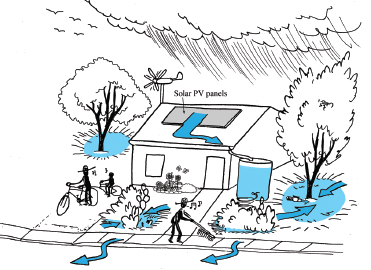
Fig. I.7B. Cleaning our water and watershed at home. Compare to figure I.7A.
Box I.9. Cleaning Tips and Stories
• Keep the crap out of our water. Defecating in the potable water that typically fills our flush toilets costs us billions of dollars, and billions of gallons of water, annually as we try to remove the feces and other contaminants. Toilets account for up to 30% of all indoor potable water use in a typical U.S. residence.48 Switching from older, more consumptive toilets to more water efficient 1.0–1.6 gallon per flush toilets can cut that indoor water use by 15–25%.49 Waterless composting toilets use no water and turn the users’ wastes into high-quality fertilizer.
And then there’s the annual “Pee Outside Day” in Sigmota, Sweden, when 50% of the water normally used in toilet flushing is saved.50
• Water harvesting is being used to clean up Los Angeles, California. Non-profit organization Tree People has spearheaded a program encouraging rainwater and greywater harvesting at residential, business, industrial, and public sites in Los Angeles to clean up pollution and reduce the city’s dependence on imported water by up to 50%! Water-harvesting yards, commercial landscapes irrigated by greywater, and sunken ball fields are acting as flood controlling greenfrastructure promising significant reduction in runoff pollution into Santa Monica and San Pedro Bays, and the simultaneous removal of the 100-year flood threat on the Los Angeles River. The municipal flood control department—renamed the Watershed Management Division—is subsidizing this work since it reduces the need for expensive, single-purpose flood-control infrastructure.51
HOARDING VERSUS CYCLING WATER
Living the wasteful path to scarcity
We hoard water as a community by draining, over-extracting, and polluting our local water sources, and instead of changing our policies, lifestyles, and habits to reduce our needs, we divert water from other locations and people.
On an individual level, we watch our local water supply decline even as we buy bottles of imported spring water. We support massive dam and canal projects that divert water from others to support our demands.
Diversions and competition for water are contributing to its commodification, as water shifts from a social resource belonging to all life, to an economic commodity bought, sold, and managed by corporations that profit from the increasing scarcity of water. Water is sold to those thirsty people who have similarly squandered their water, or from whom we have taken it. (See figure I.8A.)
Fig. I.8A. Water hoarding. Large dams often hoard water from those downstream, and even other watersheds, when canal or piping systems divert water to the dams from other regions.
Box I.10. Hoarding Facts
More than half of all accessible fresh water is now diverted for human use.52
Only 2% of America’s rivers and streams remain free-flowing and undeveloped.53
In 1996, the residents of the high desert city of Albuquerque, New Mexico had to decrease their water use by 30%, while Intel Corporation was allowed to increase its use by the same amount. Intel pays four times less than the city’s residents for water.54
The U.S. Global Water Corporation has signed an agreement with Sitka, Alaska, to export 18 billion gallons per year of glacier water to China where it will be bottled in one of that country’s “free trade” zones to exploit cheap labor. The company brochure tempts investors “to harvest the accelerating opportunity … as traditional sources of water around the world become progressively depleted and degraded.”55
Living the path to abundance
We cycle our water as a community by increasing the productivity and potential of our limited fresh water by cycling it—using it again and again. The more life forms, uses, and resources through which fresh water cleanly cycles, the more life forms, uses, and resources the water can generate and support.
We stop draining, over-extracting, and polluting our local water sources by changing our policies, lifestyles, and habits to reduce water needs.
We take personal responsibility for how we treat and consume water, recognizing the negative impacts of buying imported bottled water and supporting massive water diversion schemes, and choosing instead to avoid these hoarding behaviors.
We work to prevent and reverse commodification of water by assisting people locally, nationally, and internationally to harvest rainwater, make use of grey-water, and reduce demand for secondary water sources. Water scarcity attracts market forces; water abundance does not. Water is part of the Commons (box I.12), to which we are all entitled. (See figure I.8B.)
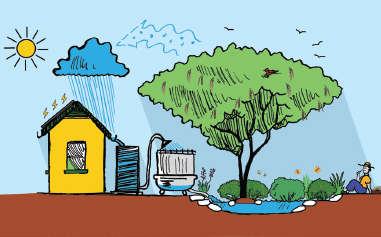
Fig. I.8B. Water cycling along with the harvest of sun, shade, and food
For more information on how to protect the right to clean water for all citizens of the earth (including wildlife) see the resources appendix on my website HarvestingRainwater.com.
We can consume just 100 gallons (379 liters) cycled through five uses, rather than consuming 500 gallons (1,893 liters) of water in a week for five different uses. And, we can harvest that 100 gallons of water from roof runoff. For example:
• Bath water. Harvest rainwater from roofs into a tank and bathe with it in an indoor or outdoor shower. (See chapter 4 for an example, with much more in volume 3.)
• Irrigation. Direct that shower greywater to shade trees and 100 gallons of shower water becomes 100 gallons of irrigation water. (See chapter 4, and volume 2, the chapter on greywater.)
• Cooling. Place those shade trees on the east and west sides of a building to cool air both outside and inside. This can reduce mechanical cooling that would otherwise consume 100 gallons of water in an evaporative cooler, or 100 gallons in electricity generation for an air conditioner.56,57,58 (See chapter 4 in this volume for much more on using trees in integrated design.)
• Food. Select food-bearing shade trees and each 100 gallons of harvested rainwater offsets the need to use 100 gallons of water to grow food in a distant orchard. (See the plant list in appendix 4 as well as volume 2, the vegetation chapter.)
• Fertilizer. Collect fruit and leaves that drop to the ground around the base of the trees to create rich, water-conserving mulch, reducing the need to pump 100 additional gallons per week for irrigation. (See volume 2, the chapter on mulching.)
Box I.12. Water as Commons
I use the term “commons” as defined by Vandana Shiva in her book Water Wars, in which she writes, “Water is a commons because it is the ecological basis of all life and because its sustainability and equitable allocation depend on cooperation among community members.”59
Box I.13. Water as a Human Right
Water is a limited natural resource and a public good fundamental for life and health. The human right to water is indispensable for leading a life in human dignity. It is a prerequisite for the realization of other human rights.
—United Nations, 200260
MY COMMUNITY’S PATH
Today, most of Tucson’s 11 plus inches (282 mm) of average annual rainfall pours off roofs, yards, parks, and parking lots creating torrents of street runoff that flow to storm drains (Fig. I.9) generating the “need” to import water. Yet from over 4,000 years ago up until the early 1870s, human residents of the area relied entirely on easily obtained rainwater, runoff, surface water, springs, and shallow hand-dug wells. Then Tucson shifted to relying primarily on groundwater extracted with mechanical pumps from natural aquifers beneath the city and surrounding valleys to serve municipal, agricultural, and industrial uses. In the past 100 years, decades of extracting groundwater at rates exceeding natural recharge have put ground and surface water out of reach, unless one has a mechanical pump to access the water from ever-increasing depths. Overpumping has lowered this groundwater table by more than 200 feet (61 m) in some areas, and it continues to drop an additional 3 to 4 feet (0.9 to 1.2 m) more each year in some areas.61, 62, 63 Once perennial reaches of the Santa Cruz River and numerous springs have dried up.64 Cottonwood, willow, and mesquite “bosques” or forests that used to line our waterways have died.65 Basically we have destroyed and continue to destroy many of the foundational elements of our local hydrology and ecology that enabled the Tucson area to be one of the oldest continuously inhabited areas in North America. (See figure I.10, with its “before” and “after” photos.)
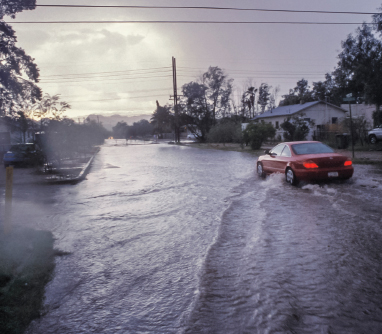
Fig. I.9. First Street becomes “West University Wash” in a summer storm.
Fig. I.10A. The Santa Cruz River in Tucson, Arizona looking northeast from the base of A-Mountain in 1904. Note the braided running water, densely vegetated watershed, and cottonwood (white), willow, and mesquite trees growing in the floodplain. Credit: Arizona Historical Society/Tucson, AHS Photo # 24868
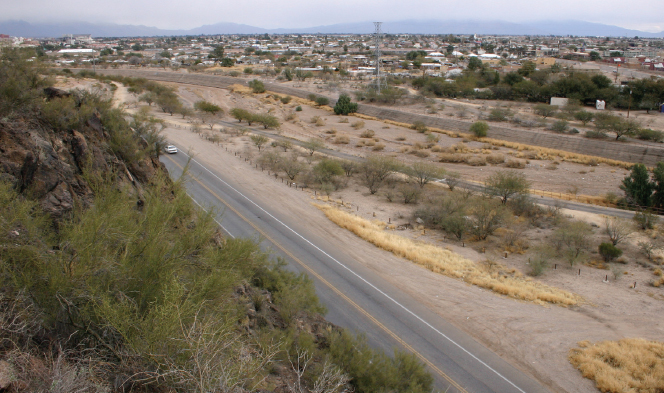
Fig. I.10B. The same stretch of the Santa Cruz River in 2007. Note the dry, channelized riverbed, and how much of the watershed has been replaced with paving, buildings, or bare, compacted earth. The cottonwood, willows, and most of the mesquites have disappeared with the depleted water table. The river park landscape drains most runoff to the riverbed and is dependent upon a drip irrigation system.
See Audio page at HarvestingRainwater.com to hear Sing Back the River song about the Santa Cruz
Pollutants from local landfills, businesses, and industry have migrated down to our aquifer, creating several Environmental Protection Agency (EPA) Superfund sites.66 As we have polluted and depleted our local water supply, we’ve bought thousands of acres of farmland in surrounding valleys to obtain their groundwater pumping rights for our use. We have spent over 4 billion dollars to construct, and 60 to 80 million dollars a year to operate, the Central Arizona Project (CAP), which diverts water from the Colorado River and pumps it 2,400 feet (731 m) uphill in an evaporation-prone canal over 336 miles (540 km) through the desert to reach our city. Thus the canal and its pumps have become the state’s single largest consumer of electricity, and emitter of carbon dioxide (via the coal-fired power plant that provides its electricity).67 That imported Colorado River water via CAP is now the primary water source for Tucson, but we continue to overpump our groundwater at a rate that exceeds natural recharge.
Projected population growth and increased water use is predicted to outstrip Tucson’s “renewable” water supplies by 2025.68 The Colorado River— designated America’s Most Endangered River due to mounting problems with radioactive, human, and toxic waste in the water69—has been over-allocated to the point that the southernmost reaches of the river are severely diminished, crippling much of the Colorado River Delta’s ecosystem and economy.70 If the states upstream from Arizona on the Colorado River, and if Mexico below, take the full shares of Colorado River water granted them there will not be enough water left to meet Arizona’s needs and fill the CAP canal in drought years.71 In the meantime, we are importing about 2,000 pounds (907 kg) of salt with every acre-foot of CAP water we pump into the Tucson area.72 That salt is an additional challenge and can become a contaminant for the already salt-prone alkaline soils of our desert environment.
We can make a shift. A ¼-acre (0.1-ha) lot in Tucson receives about 67,000 gallons (253,600 liters) of salt-free rain in an average year. The average single-family residence in Tucson (assuming three people) uses about 120,000 gallons (454,200 liters) of water a year, and roughly half of that is for outdoor use. This suggests that most residential outdoor water needs could be met by harvesting the rainwater that falls on the property instead of pumping groundwater—especially if low water-use native plantings are integrated into the landscape design.73 Reducing Tucson’s consumption of groundwater and imported surface water is the key to shifting our city toward sustainable balance with our local water resources.
Tucson’s average rainfall actually exceeds our current municipal water use (see box I.14), but most of this rainfall is drained away or lost to evaporation. Harvesting more of that rainwater, coupled with more conservation, brings us to our alternative path.
Box I.14. Rain, Rain, Everywhere … Can We Stop To Think?
According to sustainable development consultant David Confer:
• More free, local rainwater falls on the dryland city of Tucson than the entire community consumes of purchased, imported municipal water in a typical year.
This was determined by dividing the average annual precipitation falling on the surface area of Tucson, Arizona by its 2010 population (520,116), then dividing again by 365 days per year, to find there is approximately 231 gallons per person (capita) per day (gpcd) (874 liters pcd) of rainwater compared to a (2012) total use (potable and non-potable or reclaimed water) of approximately 177 gpcd (670 lpcd) delivered by municipal water companies for municipal and industrial uses.74
• As population densities increase, available rainfall gpcd will decrease. This would eventually become a problem if rain was the source of potable water, but it is not a problem for meeting the water needs of landscapes, because as population density increases, hardscape density also increases. In densely developed areas of Tucson, as much as ¾ of the land is hardscape consisting of roofs, roads, parking lots, driveways, and sidewalks. If the rainwater that falls on hardscape was directed to and infiltrated within the remaining areas still available for vegetation, the 11.12 inches (282 mm) average annual rainfall is concentrated fourfold, to almost 45 inches (1,143 mm) per year. This approximates the annual rainfall in Columbus, Georgia (48 inches or 1,219 mm). This does not mean we can or should now plant the vegetation of Georgia in Tucson—our rainfall patterns are more erratic, and our evapotranspiration rates are higher than Georgia’s. Rather, this illustrates the large volume of local rainwater we currently ignore or expel. The bulk of Tucson’s rainfall is currently lost to runoff and evaporation. Nobody really knows the figure, but estimates of up to a 90% loss seem reasonable.75 (See figure I.11.)
Fig. I.11A. A property losing 75% of its annual rainwater by directing the runoff from the impervious 75% section of its surface area (roof and driveway) to the street. Evaporation adds to the water loss.
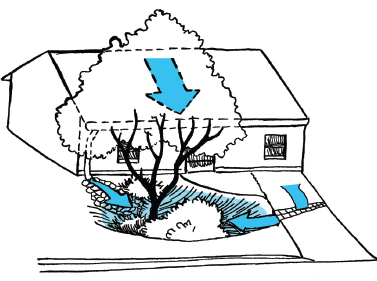
Fig. I.11B. The same property harvesting, and utilizing, 75% more of its annual rainwater by directing the runoff from the impervious roof and driveway into the permeable, sunken, and vegetated quarter of the site.
Note: Sites with less permeable yard space and more impermeable hardscape will likely require a rainwater tank in addition to vegetated basins to handle the runoff.
OUR PATH TO ABUNDANCE
By cycling the water we infiltrate, conserve, and clean within our lives and landscapes, we empower ourselves to do far more with far less. So, more is available for everyone, creating abundance. We enhance our own water resources and those of others, especially those downstream and downslope. Rather than commodifying fresh water or turning it into a limited-access commodity to be bought, sold, and hoarded, we communify it by working together to enhance our local water resources and manage their fair use and equal accessibility. As we enhance our natural resources (our “commons” (box I.12)) within our own lives and throughout our neighborhoods, the “community watershed” and the community resources are enhanced many times over!
This must occur in the more water consumptive government, commercial, agriculture, and industry sectors as well as at home, but at home is where it begins because every government official, teacher, student, businessperson, farmer, and industry worker lives in a home. If we realize the potential of water harvesting at home where it is easiest to do so, we can realize it elsewhere, because we will have learned from direct experience, we will be motivated by our success, and we will be living the example we are trying to set.
The main goal of the abundance path is to use less water than nature renewably provides while consistently improving water quality, flow, and dependability and as a result, decreasing groundwater pumping and eliminating the need to import water. The first step is to strive to harvest more rainfall in our landscapes than we use from municipal water sources or private wells. This leads to a more sustainable hierarchy in the household and community management of our water resources in which:
• Rain is our primary water source (Fig. I.12);
• Greywater is our secondary source;
• Municipal water or groundwater from wells is strictly a supplemental source used only in times of need.
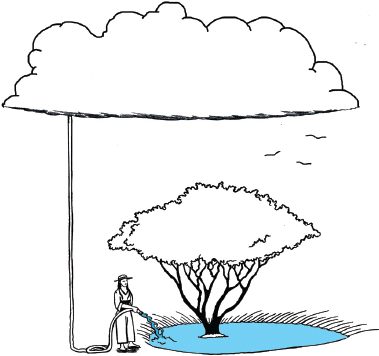
Fig. I.12. Rain as our landscape’s primary water source
Think about how rainwater can be your primary water source, not just for your landscape, but for domestic needs as well. The following chapters and volumes show you how to do both.
So read on, harvest some rain, and grow abundance. Yet be warned: Once you start putting this information to work, every rainstorm could pump you with so much excitement and wonder that even if it’s 3 A.M. when the clouds break you’ll be running outside in your underwear to watch your landscape soaking up the water!
Good luck, and may your water-harvesting endeavors be all wet!
QUESTIONS AND ANSWERS ABOUT RAINWATER HARVESTING
Some short answers to questions I am often asked:
Doesn’t harvesting rainwater deplete the water resources of those downstream?
The objective of most water harvesting is to create a “forested hillside” effect in your landscape and community that slows, not stops, the flow of water. This is because a forested hillside that quickly absorbs rainfall, then slowly and consistently releases it from its spongy soils over a period of weeks, months, or years, is much healthier for the stream below it than a denuded hillside that rapidly sheds water, creating sudden, sediment-laden flows downstream that dry up after just hours or days.
Water-harvesting strategies can reduce the amount of surface runoff traveling downstream, but they usually enhance the flow of wells, springs, streams, and rivers, because you are absorbing and cycling water in the landscape rather than quickly shedding it.
This book and especially volume 2 present examples of rainwater-harvesting strategies that turned sporadic flow of streams and rivers into dependable year-round flow, of well levels that rose, and the creation of ephemeral springs. Water resources were enhanced for those downstream as well as for those doing the harvesting.
Is rainwater harvesting legal?
Everywhere I’ve been and inquired, harvesting rainwater in the soil of one’s own property with simple earthworks as advocated in this book is legal. It is important to note that these strategies help rehydrate our soils, and do not divert or impound water from natural channels, streams, and rivers.
On public land, laws can vary and permits are often required. In Tucson, Arizona it used to be illegal to cut the street curb to direct street runoff into public right-of-way street-side water-harvesting basins that passively irrigate street trees shading the street. Now it is legal with a simple permit. Successful local pilot projects; examples from other communities such as Portland, Oregon; public demand; and communicating the many integrated benefits (flood control, improved stormwater quality, reduced groundwater pumping and water use, cooler and more liveable streets/neighborhoods, etc.) helped change the law.
Harvesting roof runoff in a tank(s) is legal almost everywhere, and in places where it wasn’t, some laws are similarly changing. For example, this practice used to be illegal throughout the state of Colorado, where it was assumed 100% of the precipitation falling on a site ultimately contributed to stream flows to which many had claimed water rights. These laws did not account for the fact that some of the precipitation was historically consumed by native vegetation and never made it back to the stream.76 This was proved with a 2007 study based on empirical methods using historical climate data for the study site in Douglas County, Colorado, which found that on average 97% of the precipitation falling on the undeveloped, naturally vegetated test site infiltrated the soil and was consumed by the native vegetation.77 Even in years of heaviest rainfall no more than 15% of the precipitation would leave the site as runoff.78, 79 As a result, in 2009 two bills passed, allowing the limited harvest of residential roof and impermeable surface runoff in tanks within approved pilot-project housing developments; or from rooftops where the owner uses, or is legally entitled to, a well.80
Ask your authorities about any local, state or national laws or requirements/permits that might affect if, how and where you can harvest water. And if needed, advocate for change.
Do I need a tank or cistern to harvest rainwater?
Not necessarily; you can often easily and effectively harvest rainwater in the soil with simple earthworks presented throughout volume 2 (chapter 3 in this volume provides an overview of some of these). In fact, it is almost always less expensive to harvest the rain in the soil than in a tank, as the soil is already there, and has a far greater storage capacity.
Doesn’t rainwater harvesting mean you’ll have standing water in which mosquitoes can breed?
Rainwater Harvesting for Drylands and Beyond stresses small-scale strategies that can easily absorb harvested rain into the soil within a couple of hours after a storm. Mosquitoes need water standing for more than three days to complete their life cycle from eggs into adults.81
If you are harvesting rainwater in a cistern rather than the soil, you simply ensure that mosquitoes have no access. Techniques in chapter 3 show how to keep sunlight (which encourages algae and bacteria growth), insects, and critters out.
Does it cost a lot to harvest rainwater?
If you harvest rainwater in the soil and you are doing the work yourself, it can be free. If you hire someone to create a rainwater-harvesting landscape for you, it should not cost much more than for a conventional landscape. No additional materials are required; you mainly just need to move more dirt.
If you are installing a cistern the cost will depend on the size and manufacture of the tank, how you plan to plumb it, and how you plan to use the water.
A cost-effective approach is to develop a water budget. Figure how much water can reliably be obtained and sustained on site, then determine what means of harvesting best meets your needs. (See chapter 2 for more.) Passive water-harvesting earthworks (chapter 3 and volume 2) are typically 50 times cheaper than cisterns and can hold far more water. They can be used throughout a site’s landscape, and are excellent for passively harvesting dirtier stormwater runoff—such as from streets and walkways—and greywater and air-conditioning condensate. Use active systems (cisterns) to back up your passive system in drought. Only harvest a site’s cleanest and most easily harvested water (typically from rooftops) in cisterns, so you’ll get the most for your tank investment. Direct cistern overflow to water-harvesting earthworks.
Water-harvesting rebates, grants, and/or credits may be available in your area. Inquire with your local water or conservation department, and enter “financial incentives” in the Search box at HarvestingRainwater.com for a few I’ve listed.
Can I find a competent person to create my own water-harvesting landscape or system?
Rainwater harvesting is starting to become more commonplace, and while some areas have skilled designers and installation crews, many are lacking in such resources. This book is meant to help more people become knowledgeable and skilled at water harvesting. Use it to guide a landscape architect if you hire one, or a crew doing the work on the ground. You will most likely need to do more supervising, but hey, you’ll get a better job that way. Be careful whom you hire, check out the quality of their work, show them this book, and see how willing they are to work with you and new ideas. Think about doing things yourself or with the help of friends. You’ll learn a lot more and save money. As you learn by doing, you gain the skills that enable you to help others.
Are there rainwater-harvesting building codes?
The International Building Code recommends avoiding the infiltration of water into soils within 10 feet (3 m) of a building’s foundation. If you have a basement, you may want to avoid infiltrating water within 20 feet (6 m) of the foundation. Other than this, check with your local building inspector. The International Residence Code (IRC) states no permit is needed for “Water tanks supported directly upon grade if the capacity does not exceed 5,000 gallons (18,927 liters) and the ratio of height to diameter or width does not exceed 2 to 1.” Otherwise tanks need a permit. For example, the State of Ohio Department of Health and the State of Virginia Bureau of Sewage and Water Services regulate rainwater cistern systems, though in most counties and municipalities the unwritten code is “CYB”—“Cover Your Butt.” That’s exactly what the water-harvesting principles and strategies in this text strive to do for you. Follow them all and you won’t have any mosquito, flooding, or drowning problems.
Do I need to own property to harvest water and the other local resources highlighted in this book?
No. The first step is to learn how, and you are doing just that by reading this book. But for a more specific list of options type “What Renters Can Do” in the Search box at HarvestingRainwater.com. There are more options than we have space for in this question and answer section.
How can I learn more about water harvesting?
Do it! There is no better way than hands-on experience.
You can also look to the Books’ Resource Appendices (Volume 1) page at HarvestingRainwater.com for a few of the organizations that offer courses in water harvesting and tours of water-harvesting sites. Many other publications and videos are also listed.